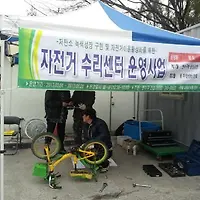District information
It is the story of our district,Yeonsu-gu
Ongnyeon-dong was originally the area including Ok-dong, Hanjin-ri (Surrounding Songdo Station today), Ongam-ri (Surrounding the entrance of amusement park today) in Meonwoogeun-myeon, Incheon-bu; however, based on the reorganization of the administrative districts conducted in 1914, Meonwoogeun, Hannaru, Dokbawi, and Songdo (Japanese referred to Songdo as the area centered in Neungheodae was filled with pine trees and the trees that stood tall over the island) were integrated and introduced into Munhak-myeon, referring to it as Ongnyeon. In 1936 at the 1st Bu area expansion, it was introduced to Incheon-bu and then called as Songdojeong in Japanese style but after the independence of Korea, it became Ongnyeon-dong starting from Jan. 1, 1946 based on the same name revision. The origin of the word Ongnyeon-dong is derived from the fact that there were many stones such as white jade. For this reason, it was called as Okdol or Okdong, and then Ongnyeon-dong. On Mar. 1, 2003, it was divided into Ongnyeon 1-dong and Ongnyeon 2-dong from Ongnyeon-dong.
Seonhak-dong was originally the area of Gueup-myeon in Incheon-bu and called Dojae or Dojang. However, it was integrated with Mujimul and Neugakbu-ri in accordance to the reorganization of the administrative districts in 1914. Later, it was referred to as Dojang-ri and introduced to Munhak-myeon but during the 2nd Incheon Bu area expansion promoted in Apr. 1, 1940, it was introduced to Incheon-bu again and called Muhakjeong in Japanese style. Since the same name revision conducted on Jan. 1, 1946 after the independence of Korea, it has been called as Seonhak-dong.
Yeonsu-dong was originally the area of Meonwoogeun-myeon, Incheon-bu but based on to the merging of administrative districts in 1914, Busuji, Saemalteo, Jangseungbaegi, Mari Guremaegi, Meogumi, Saemal, Gaenggoji, Baekkopburi, and Hambakmae were integrated and referred to as Yeonsu-ri. It was then introduced to Munhak-myeon. In the 2nd Incheon Bu area expansion promoted in Apr. 1, 1940, it was introduced to Incheon-bu again and called Yeonsujeong. After the independence of Korea, it became Yeonsu-dong from Jan. 1, 1946 based on the same name revision. Yeonsu-dong was named as it is located on the southern part of Mt. Munhak. With its warm atmosphere and good sea breeze, Yeonsu-dong is a good place for managing one’s health.
Cheonghak-dong was originally the area of Meonwoogeun-myeon, Incheon-bu. Based on the merging of administrative districts conducted in 1914, Cheongneung, Dwitgol, Mulpuraegol, Angol, and Okteo were integrated and called as Cheonghak-ri, taken after the names of Cheongneung and Mt. Munhak. It was then introduced to Munhak-myeon in Bucheon-gun but in the 2nd Incheon Bu area expansion promoted in Apr. 1, 1940, it was introduced to Incheon-bu again and called Cheonghakjeong in Japanese style. After the independence of Korea, it became Cheonghak-dong starting from Jan. 1, 1946 based on the same name revision.
Dongchun-dong was originally the area of Meonwoogeun-myeon, Incheon-bu. Since it is the east of Mt. Cheongryang, it was called as Dongcheon or Dongchun. Based on the merging of administrative districts conducted in 1914, Soemi, Mulpuraegol, Gakgol, Jaap, Dogul, and Dongmak were integrated and referred to as Dongchun-ri. It was then introduced to Munhak-myeon in Bucheon-bu but in the Incheon Bu area expansion promoted in Apr. 1, 1940, it was introduced to Incheon-bu again and called Dongchunjeong in Japanese style. After the independence of Korea, it became Dongchun-dong from Jan. 1, 1946 based on the same name revision.
Songdo-dong involves the entire Songdo International City that was formed by reclaiming the area in front of the nationally famous Songdo Park. Along with the development of Songdo International City, the area and population tend to be increased. It is definitely a place which is drawing tremendous attention both domestically and internationally. Songdo-dong is equipped with a legal district in accordance to Yeonsu-gu, Incheon Metropolitan City Ordinances No. 485 as of March 6, 2006 and based on the acceleration of international city development resulting from the selection of Songdo as Free Economic Zone, it was divided from Dongchun 2-dong to Songdo-dong in accordance to Article 4 of the Local Government Law on Jan. 1, 2007.








